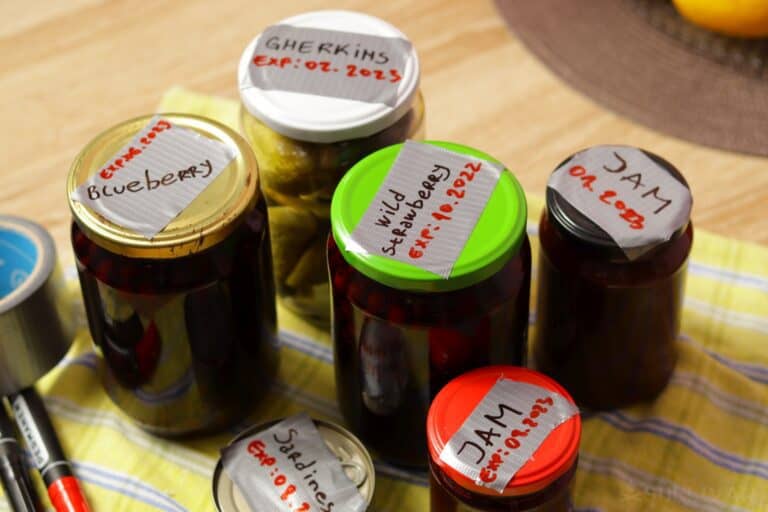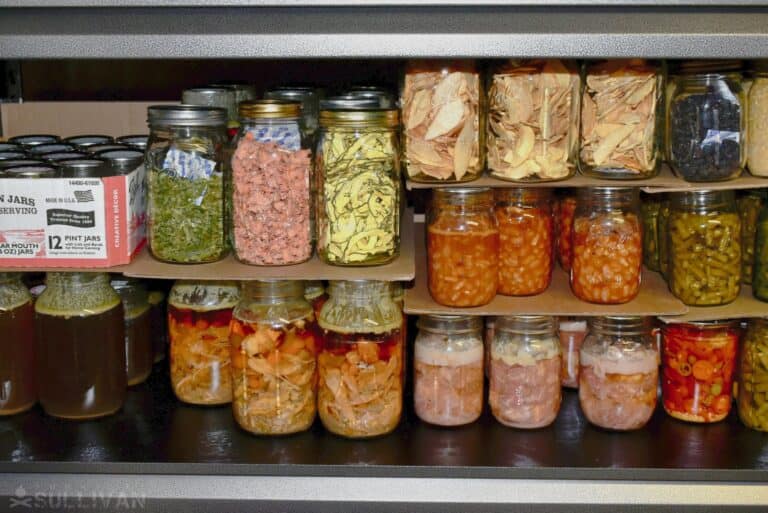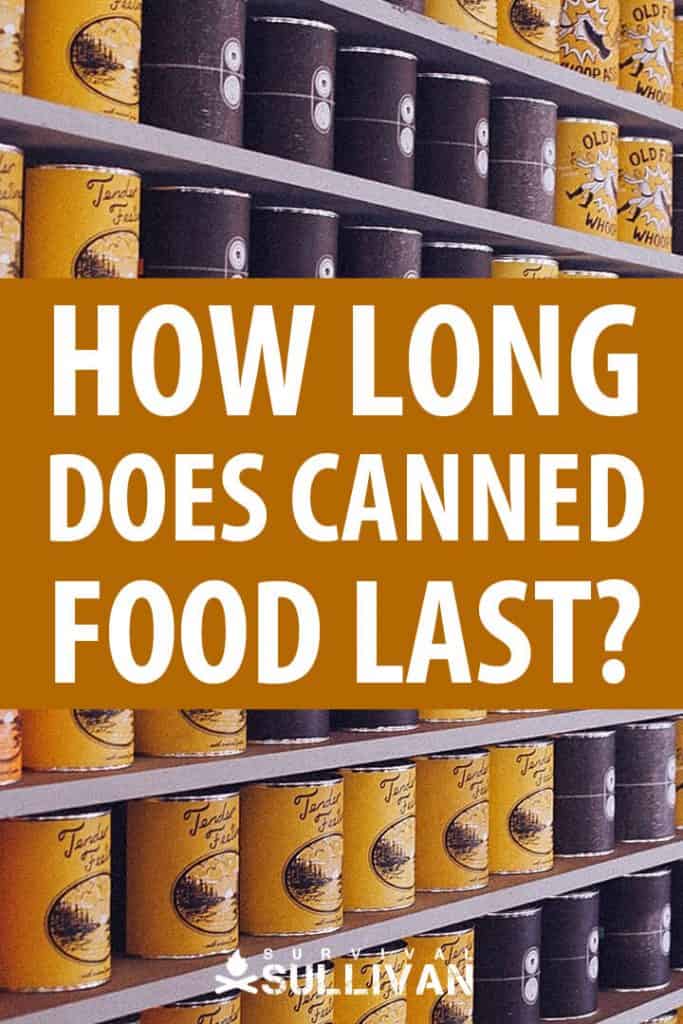Canned food, whether in jars or vacuum-packed cans, are an important part of any preppers stockpile.. You should ideally consume all of the canned food by the expiration date, and having a general idea of shelf life is important in determining that date.

There are many different types of canned food, each with characteristics that affect shelf life. Canned foods generally fall into a couple of categories that have their own set of rules to follow.
But how long will canned food last if stored properly?
High acidic canned foods will last 12 – 18 months, while low-acidic canned foods will last 2 -5 years. The lifespan is determined by the type of storage, where it’s stored, and proper canning procedures.
Having a good rotation ensures you eat the oldest product first, but do make sure the jars are in good condition, without any dents, cracks or rust.
The food storage chart on the USDA website tells us:
| Food Name | Shelf Life |
|---|---|
| Canned ham (shelf-stable) | 2 to 5 years |
| Low-acid canned goods. Examples: canned meat and poultry, stews, soups (except tomato), spaghetti (noodle and pasta) products, potatoes, corn, carrots, spinach, beans, beets, peas, pumpkin. | 2 to 5 years |
| High-acid canned goods. Examples: juices (tomato, orange, lemon, lime and grapefruit); tomatoes; grapefruit, pineapple, apples and apple products, mixed fruit, peaches, pears, plums, all berries, pickles, sauerkraut and foods treated with vinegar-based sauces or dressings like German potato salad and sauerbraten. | 12 to 18 months |
| Home canned foods | 12 months. Before using, boil 10 minutes for high-acid foods; 20 minutes for low-acid foods |
Not All Canned Goods Are Created The Same
Between commercially canned foods and foods that are preserved at home, there is a lot of variability in the art of canning. Knowing which foods last longer or store better in different conditions is an important part of learning this old tradition.
High-Acidity Foods
This category includes things such as food stored in vinegar, citrus fruits, and tomato based products. If you open a can and leave it refrigerated for more than a week then it is wise to discard the food. Expect to get at least a year to 18 months of storage with these products.
Low-Acidity Foods
Canned veggies, soups, and meats are generally found in this category. Basically anything that doesn’t include an acid inside the can.
The shelf life of these products is more robust and you can get up to 5 years of life out of them. Low-acidic foods make for excellent emergency foods when mixed with a rotational plan.
Dried Canned Goods
Sometimes dried foods can come canned, such as nuts, beans, and dried milk powder. Ensure that these products stay away from light, heat, and moisture. Once they are opened they should be consumed quickly before bacteria causing humidity gets a hold on it.

Tips On How To Properly Store Your Canned Goods
Knowing proper storage methods can keep food fresh for years past USDA regulations. In fact, the USDA itself admits canned food may be safe to consume past that point.
Here are some tips to squeeze every last bit of shelf life out of your canned goods.
- Don’t keep canned food in heat, because it will decay faster. The ideal storage temperature is 50 F to 70 F (10 C to 21 C). Find a place that is both dry and cool to store it.
- Moisture will eat away at the lid, so make sure you have a plan around this, especially if you live in a humid climate. Fans or a dehumidifier work best in this scenario.
- Do not eat from cans that are bulging or dented. This could be an indication of harmful bacteria inside the can. This also applies if you open the can and food comes shooting out.
- Label jars with the canned or purchased date. Eat the oldest ones first.
- Glass-like crystals called struvite may form in your canned fish, the FDA says they are harmless and the fish can be eaten.
- Don’t heat a can over an open flame with the lid on, it will explode and be ruined.
- Basements are the most common storage location but they can get damp and wet. A cellar is great because it stays cooler and no light can get in. The key is not letting the cans heat up for a consistent amount of time.
Signs To Throw Out Your Canned Food
The Can Lid is Popped or Cracked
The most obvious sign is if the lid itself has popped open. Of course, any physical impact may cause a rupture in the metallic storage. However, natural chemical reactions inside the food can also cause a lid to rupture. If a lid is popped up or dented, do not eat the can’s contents.
There are Streaks of Dry Food on the Can
Look for dried food streaks. This is a sign of a rupture, either from physical or chemical cause. If you find that streak comes from the top of the can, don’t eat the food. It is decayed.
Fungus is On the Lid
When you open a can, always make sure to check the lid. It will be tempting in an emergency scenario when you are hungry, to just open it up and start eating. Don’t do this. Always check for mold on the lid or bubbles in the syrup as signs that mold has infected the food.
The Food Pops Out When the Can is Opened
The food should also remain relatively still upon popping open the can. If it jumps right out when you expose it to air, this is a sign that a chemical reaction has begun in the food. Check for liquidation in this scenario as well to make sure.
Odor and Color
Above all, use your senses. If the food smells off, don’t eat it. If the food has drastically changed color, don’t eat it. This is especially true if the syrup or brine has turned muddy or opaque.
Don’t underestimate botulism. If you thin canned food may be bad don’t take the risk. It can be fatal. Although botulism isn’t a problem with commercial cans of food, it is a big one for home canned food.
This is why it’s important to always follow the canning recipe to the letter, as well as the additional instructions for using the jars, lids and other equipment. Also check the USDA home canning guidelines here.
A Somewhat Extreme Example…
In 1865, the steamboat Bertrand sank to the bottom of the Missouri river while attempting to reach Montana. A century later, the vessel was found with canned goods including mixed vegetables, plum tomatoes, brandied peaches, and oysters in its cargo.
In 1974, a chemist at the National Food Processors Association tested the food for nutrient value and bacterial infection. It was determined that, even though it wasn’t visually appealing, it was safe to eat one hundred years after the original wreck. A great deal of vitamin A and C was lost, but most protein and calcium remained.
Now, this is an extreme example. Use common sense. If food smells bad, tastes bad, and has lost its color- don’t force yourself to eat it. Find a better option.
So There You Have It…
Whenever you open a can of food, whether expired or not, you definitely want to make sure it is safe to eat. Don’t let the expiration date scare you, because canned food typically lasts longer than that… but do pay close attention to the can and the produce inside before consumption.
If you’re storing your food for long periods, ensure that you remember the things that can make your food spoil. This includes light, heat, and moisture. Avoid these like the plague and your canned goods will stay fresh long after they should.


My dad was military. My grandfather was a cop. They served their country well. But I don’t like taking orders. I’m taking matters into my own hands so I’m not just preparing, I’m going to a friggin’ war to provide you the best of the best survival and preparedness content out there.
